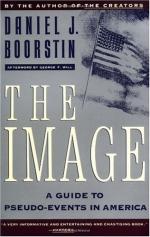
|
| Name: _________________________ | Period: ___________________ |
This test consists of 5 multiple choice questions, 5 short answer questions, and 10 short essay questions.
Multiple Choice Questions
1. What type of book binding begins with the signatures of the book as loose pages which are then clamped together?
(a) Bind-sew.
(b) Cross stitch.
(c) Oversew.
(d) Undersew.
2. When was Publishers' Weekly first published?
(a) 1849.
(b) 1872.
(c) 1959.
(d) 1805.
3. Boorstin states, regarding foreign affairs, "I suspect we suffer abroad simply because people know America through" what?
(a) Television.
(b) Images.
(c) Pseudo-events.
(d) Nonreality.
4. What does Boorstin write essentially means that people have accepted and bought into the image that we are trying to uphold?
(a) Archetypes.
(b) Prestige.
(c) Ideals.
(d) Standards.
5. What word does Boorstin suggest we created out of the need to express the specialness of that which is real, in Chapter 6 - Section III?
(a) Capitalization.
(b) Fiction.
(c) Non-fiction.
(d) Arbitration.
Short Answer Questions
1. What company advertised the fact that the bottles were "steam-sterilized," neglecting to mention the fact that all the other beer companies used the same process?
2. In Chapter 5 - Section V, Boorstin states that even ____ have become blurred because of the relentless drive of business and consumerism.
3. When does Boorstin say books began to be made cheaper, due to a variety of factors, in Chapter 4 - Section I?
4. What refers to the process or fact of personally observing, encountering, or undergoing something?
5. Boorstin concludes Chapter 6 - Section V by stating that we must be able to reach beyond into novel experiences and ideas and thus become aware of our what?
Short Essay Questions
1. What does Boorstin suggest was the impact of Reader's Digest on the populace? What is Reader's Digest?
2. What does Boorstin write of stage and film adaptations in Chapter 4 - Section VI?
3. What was the impact of Muzak, according to Boorstin?
4. Why does Boorstin believe the American image is viewed negatively by other nations?
5. How does Boorstin view the impact of advertising on the American psyche?
6. What changes took place in the binding industry for printmaking? What effect did this have?
7. What is the second aspect of "successful advertising" described by Boorstin? How is it defined?
8. What shift in the American psyche does Boorstin describe in Chapter 6 - Section I?
9. What does Boorstin assert are the greatest challenges for America and our relationship to the rest of the world?
10. What is Boorstin's subject in Chapter 6 - Section IV? How is the effect discussed defined?
|
This section contains 886 words (approx. 3 pages at 300 words per page) |

|




